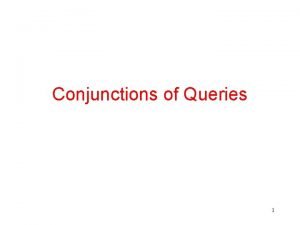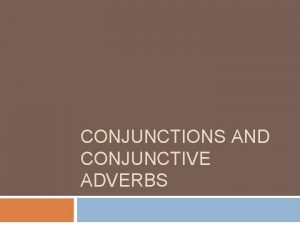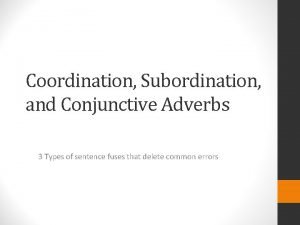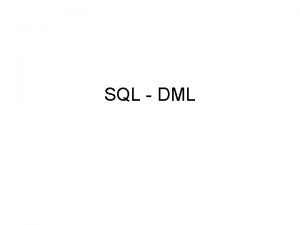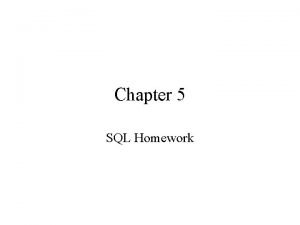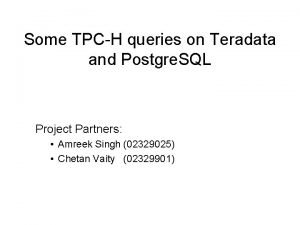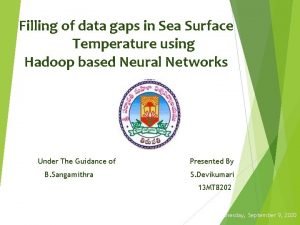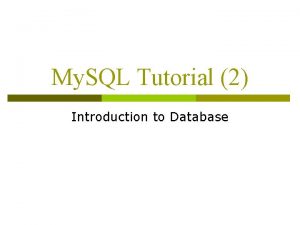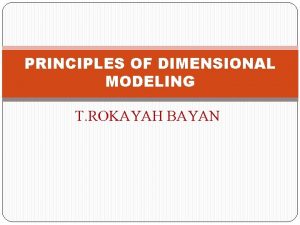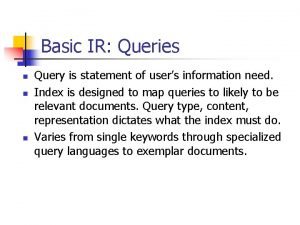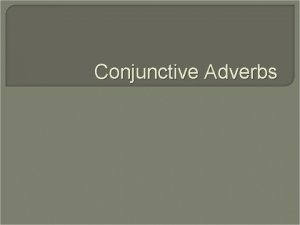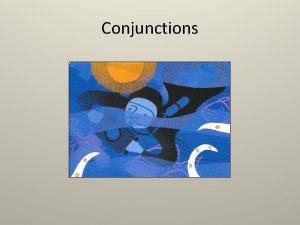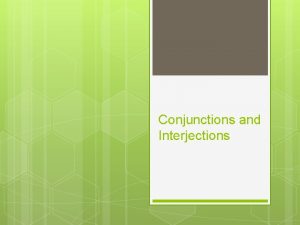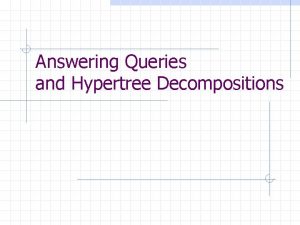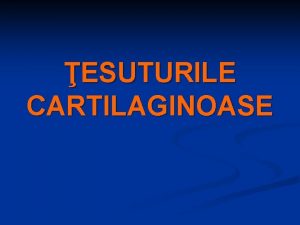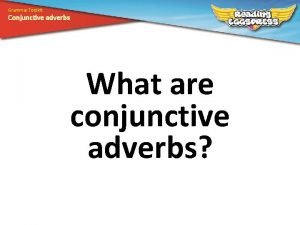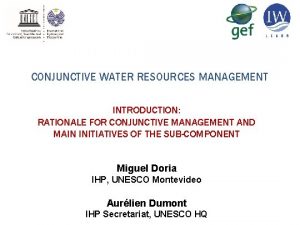Conjunctions of Queries 1 Conjunctive Queries A conjunctive

















- Slides: 17

Conjunctions of Queries 1

Conjunctive Queries • A conjunctive query is a single Datalog rule with only non-negated atoms in the body. (Note: No negated atoms and no comparisons) • A conjunctive query has only EDB in its body • We say that a query Q 1 is contained in a query Q 2 if for all databases D, the result of computing Q 1 on D is contained in the result of computing Q 2 on D. 2

Example • • Consider the queries Q 1: p(X, Y) : - e(X, Z), e(Z, Y) Q 2: p (X, Y) : - e(X, Z), e(Z, Y), e(X, W) It is easy to see that Q 2 is contained in Q 1 since any mapping that satisfies Q 2 also satisfies Q 1 Can you prove that Q 1 is contained in Q 2 ? Which of the queries is faster to compute? 3

Homomorphisms • A symbol mapping is a mapping of variables to other variables or to constants and of constants to constants • Consider the queries Q 1, defined as H 1: -B 1 and Q 2, defined as H 2: -B 2. • A symbol mapping h of the variables and constants in Q 1 to those in Q 2 is a homomorphism if: – h(H 1) = H 2 – h(B 1) is contained in B 2 4

Example • • Consider the queries Q 1: p (X, Y) : - e(X, Z), e(Z, Y) Q 2: p(X, Y) : - e(X, Z), e(Z, Y), e(X, W) A homomorphism from Q 1 to Q 2: – h(X) = X, h(Y) = Y, h(Z) = Z • Can you find a homomorphism from Q 2 to Q 1? – h(X) = , h(Y) = , h(Z) = , h(W) = 5

Containment • Theorem: Q 1 is contained in Q 2 if and only if there is a homomorphism from Q 2 to Q 1 • Proof: • (if) Suppose that there is a homomorphism h from Q 2 to Q 1. – Let D be a database. – Let f be an assignment that satisfies the body of Q 1. 6

If (continued) – Then, Q 1 returns f(H 1). – We show that f h is a satisfying assignment of the body of Q 2 that returns f(H 1). • f h(B 2) = f(h(B 2)) which is contained in f(B 1) which is contained in D f h satisfies B 2 • f h(H 2) = f(h(H 2)) = f(H 1) – Therefore, Q 2 also returns f(H 1), as required 7

Only If • (Only If) Suppose that Q 1 is contained in Q 2. We show that there is a homomorphism from Q 2 to Q 1. – Let f be a symbol mapping of the constants and variables in Q 1 to distinct constants. – Let D be the database defined by f(B 1). – Then if we compute Q 1 on D, f(H 1) will be returned. – Since Q 1 is contained in Q 2, when we compute Q 2 on D, f(H 1) will be returned. 8

Only If (continued) – Let g be the mapping of Q 2 that returns f(H 1). – We show that f -1 g is a homomorphism from Q 2 to Q 1. – Note that f -1 is well defined since f -1 is injective – f -1 g (B 2) = f -1(g(B 2)) is contained in f -1(D) which is equal to B 1 – f -1 g (H 2) = f -1(g(H 2)) = f -1(f(H 1)) = H 1 – Therefore, there is a homomorphism from Q 2 to Q 1 9

An Optimization • We can optimize the query p 2(X, Y) : - e(X, Z), e(Z, Y), e(X, W) by removing the last atom • In General: Given a query Q: For each atom a the body of Q Let Q’ be Q without a If Q’ is equivalent to Q, then remove a from Q • Note that is is sufficient to check if Q’ is contained in Q 10

Containment with FDs • Consider the queries Q 1: p(X, Y) : - e(X, X), e(X, Y) Q 2: p (X, X) : - e(X, X) • Then Q 2 is contained in Q 1. • However Q 1 is not contained in Q 2. • What about if we know that the first column in e functionally determines the second column? 11

The Chase • Given a query and a set of FDs, we apply a chase of the FDs to the query by finding any contradiction to a FD and “fixing it” by equating the tail. • For example, we chase with e: $1 $2 p(X, Y) : - e(X, X), e(X, Y) p(X, X) : - e(X, X), e(X, X) 12

Checking Containment • In order to check containment we first apply a chase to both queries and then check for a homomorphism. • Can you prove that this process is correct? 13

Checking for a Lossless Join • Suppose R=(C, D, E), R 1=(C, D), R 2=(D, E) and F={C D, D E} • We want to check if for all instances r of R, r = R 1 (r) R 2 (r) • A row (A 1, A 2, A 3) is in R 1 (r) R 2 (r) if there is some row (A 1, A 2) in R 1 (r) and some row (A 2, A 3) in R 2 (r). • A row (A 1, A 2, A 3) is in R 1 (r) R 2 (r) if there is some row (A 1, A 2, B 1) in r and some row (B 2, A 3) in r. 14

Checking for a Lossless Join • We can express the rules stated above by Q 1: p(A 1, A 2, A 3) : - r(A 1, A 2, B 1), r(B 2, A 3) • Q 1 expresses the set of rows in R 1 (r) R 2 (r) • We can express the set of rows in r by Q 2: p(A 1, A 2, A 3) : - r(A 1, A 2, A 3) • So, r = R 1 (r) R 2 (r) if and only if Q 1 is equivalent to Q 2. • Note that Q 2 is always contained in Q 1. • To check containment of Q 1 in Q 2, apply the chase and then look for a homomorphism from Q 2 to Q 1. • There will be a homomorphism iff one of the atoms in the 15 body of Q 1 contains only a-s.

Checking for a Lossless Join • Suppose R=(C, D, E), R 1=(C, E), R 2=(D, E) and F={C D, D E} • Create the queries: Q 1: p(A 1, A 2, A 3) : - r(A 1, B 1, A 3), r(B 2, A 3) Q 2: p(A 1, A 2, A 3) : - r(A 1, A 2, A 3) • Note that Q 2 is contained in Q 1 • Q 1 is not contained in Q 2, even after applying a chase, since after applying the chase there is no rows with only a-s. 16

General Algorithm • Given a relation R with m attributes and a decomposition R 1, . . . , Rn: – For each Ri, create an atom r with Aj in place j if the j-th attribute of R is in Ri. Put unused variables in the rest of the places. – Create a rule with head p(A 1, . . . , Am) and all the atoms from before in the body – Create a rule p(A 1, . . . , Am): -r(A 1, . . . , Am) – There is a lossless join iff the queries are equivalent 17
 Conjunctive queries
Conjunctive queries Types of conjunctive adverbs
Types of conjunctive adverbs Conjunctive adverbs vs subordinating conjunctions
Conjunctive adverbs vs subordinating conjunctions Codeapillar troubleshooting
Codeapillar troubleshooting Sql queries
Sql queries Wide world importers sample database
Wide world importers sample database Hotel.hotelno=room.hotelno(hotel room)
Hotel.hotelno=room.hotelno(hotel room) Action queries in access
Action queries in access Disadvantages of eye gaze communication system
Disadvantages of eye gaze communication system Tpch queries
Tpch queries Any queries
Any queries Suggestions and queries
Suggestions and queries Sql insert update delete query
Sql insert update delete query Sql queries for banking database
Sql queries for banking database Any queries slide
Any queries slide Texas railroad commission query
Texas railroad commission query Basic ir
Basic ir For any queries
For any queries
